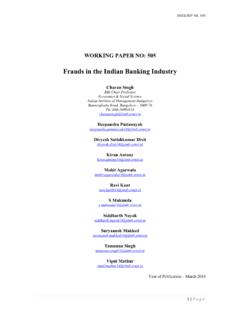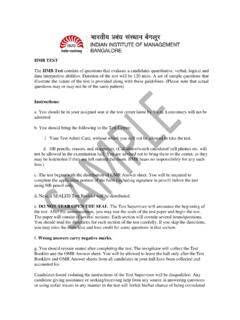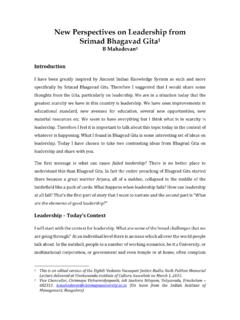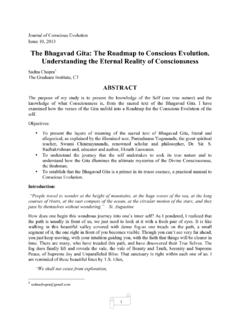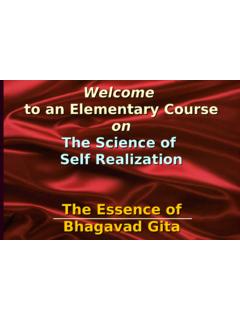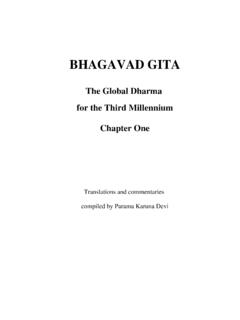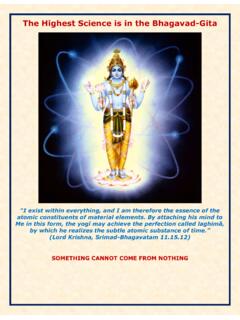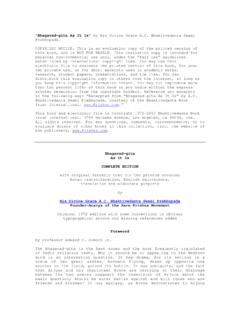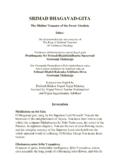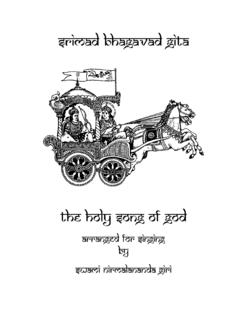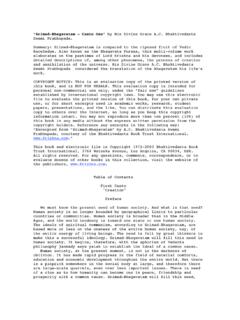Transcription of Srimad Bhagavad Gita - iimb.ac.in
1 Srimad Bhagavad Gita Ideas for modern management B Mahadevan1 Introduction Bhagavad Gita is one of the most popular of the ancient texts not only among the Indians but also among the westerners. In fact Robert Oppenheimer who successfully exploded the first atom bomb on July 16, 1945, at Alamogordo, New Mexico was greatly attracted by Gita. Watching this event from a distance, he was supposedly uttering a phrase from Bhagavad Gita2. Bhagavad Gita has inspired many of our national leaders and provided them strength, moral courage and clarity of thought with which they have led the country in its struggle. Arguably, these are important elements of making a good manager or a leader today. Here lies the motivation for today s talk. But what really is interesting is that the ideas that we will see today are available not only in Bhagavad Gita but also in the ten Upanishads and for that matter in several ancient Indian texts. At the outset let me clarify that I do not claim to be an expert in these texts.
2 However, I have been going through the process of reading these texts through appropriate methods. By appropriate methods I mean initially learning from a Guru and then reading oneself the Moola Mantras supplemented by reading the commentaries by other well known personalities in the subject matter. Before I point to one or two interesting aspects of management from Gita, it is important for me to illuminate to the audience here the multi-faceted nature of the ancient Indian texts. We need to get this aspect abundantly clear so that the real value of the ancient Indian texts is fully understood. Further it also informs us that only if we approach the ancient Indian texts with such a perspective we will be able to gainfully understand its usefulness to solve today s problems. Ancient Indian texts Multi-faceted perspectives First of all we must understand that the Ancient Indian texts could be read with different purposes. For example, a true bhakta of Lord Krishna may want to read Gita as it is a matter of religion to him.
3 He may do a daily paraayana of some of the verses. Many of us can identify with this role. On the other hand, a student of philosophy or a person with a deep desire to search the inner truth or meaning of self or a spiritual seeker may view Gita as a spiritual text. Again some of us may fit into this role. But there is a third aspect to Gita and other such texts, which many of us are not aware of. Many of us perhaps did not also think of such a possibility. I want to bring this to your attention. This is what I call as secular or a material perspective. 1 This is an edited version of the talk delivered by Professor B Mahadevan, Dean (Administration), Indian Institute of Management Bangalore in a seminar on Towards a New Paradigm of Business management Alternative Perspectives from Ancient Indian Wisdom , held at IIM Bangalore on December 12, 2009. 2 Srimad Bhagavad Gita: Ideas for Modern Management P a g e | 2 What I mean by this is a set of ideas that help us conduct our life sensibly more from a day to day, working perspective.
4 I call it is as secular because in this perspective there is no need to bring in the notion of religion or spirituality. I hasten to add that by bringing these additional dimensions it only makes the utility much better. Therefore I find in all these ancient texts three distinctive angles. It all depends on how we want to read it. Let me take you through a couple of examples from Gita to drive home this point and bring some more clarity to the idea that I am proposing. Is Gita a Religious text or a Secular text? Let us look at a pair of famous shlokas famous because it was a title song for the Mahabharata serial. Therefore most of us are very familiar with these shlokas. yda yda ih xmRSy Glain-Rvit -art, A_yuTwanmxmRSy tdaTman< s&jaMyhm!. pir a[ay saxUna< ivnazay c :k tam!, xmRs<SwapnawaRy s<-vaim yuge yuge. For the first time in Bhagavad Gita Krishna manifests himself as God through these two shlokas. In the first three chapters he has been engaging in conversation with Arjuna more from a level of a cousin.]
5 That is what we implicitly infer from a reading of the Gita. Quintessentially this is the Avathaara Purusha dimension brought through this Shloka. At a first reading one can easily detect the religious angle. Whenever there is a deterioration of dharma the God takes one more incarnation (Avathaara) to uphold the dharma. The incarnation of God, as the next Shloka suggests, is to protect the good people, destroy the evil ones and restore Dharma in the society once again. That is how the Avathaara Purusha tatva manifests here in terms of the context, motivation and purpose of the incarnation. This is one way of looking at it. I will show you another dimension to it. The same shlokas could be understood as a profound management concept because that is what you will find in the instructions of many engineering and management schools. Let me share with you this perspective with respect to these shlokas.
6 Stability and long term sustainability of the system happens because there are regenerative points. When the system attains disequilibrium and shows signs of being unstable and going out of control measures have to be taken to restore the equilibrium in the system. This is a classical systems engineering idea according to which there are Srimad Bhagavad Gita: Ideas for Modern Management P a g e | 3 regenerative points in the system. If the regenerative points are not there, the system will go unstable. One can easily relate this to some well known concepts in Economics & Management. These could indeed be explained with this. The demand supply equilibrium, pricing decisions in alternative market structures, the way in which organizations continue to root out bad CEOs or Managers over time, the mechanisms to prevent opportunistic behaviours in the long run (and variations of this such as Prisoner s Dilemma) could all be explained by this basic axiom laid out in this shloka.
7 Is Gita a Spiritual text or a Secular text? Let us look at one more example. In chapter 2 of Gita, when Krishna begins his set of arguments to convince Arjuna the need to fight against the Kaurava army, the first idea he brings into focus is the notion of time. When you read it what strikes you is that this idea is in stark contrast to modern day pre-occupations with quarter-to-quarter guidance ritual that investment bankers are going after. However that is not the point of my discussion now. Let us look at one of the shlokas from this argument of time and its impact. vasa<is jI[aRin ywa ivhay nvain g& ait nrae=prai[, twa zrIrai[ ivhay jI[aRin ANyain s<yait nvain dehI. The easy and direct meaning to this shloka runs as follows: Just as a person discards an old and a torn shirt and wears a new one, the soul (Atma) also discards an old body and acquires a new one. What a simple way to explain a complex idea of a chain of birth and death events!]]]]
8 There is a spiritual angle to it. It is a profound spiritual thought here and true seekers of knowledge will revel on this idea and deeply contemplate. Now I will provide another way of looking at the meaning of this shloka. In order to be successful and sustainable organizations need to continuously engage themselves in discarding old ideas (mind set!) & embrace new ones. This is the fundamental building block of innovation and creating competitive advantage. Srimad Bhagavad Gita: Ideas for Modern Management P a g e | 4 When I read this shloka and tried to interpret it this way, what came to my mind is the recent work by Joseph Schumpeter3 on creative destruction and innovation followed by a number of other researchers. Don t you think the ideas are available in this shloka? The most important issue in management of change is one of mind set. The biggest challenge in organizations is mind set inertia. You can discard many things but mindset is very difficult to discard.
9 This puts realistic limits to creating better organizations over time. Another example can be found in a paper titled May the Whole Earth be Happy: Loka Samstat Sukhino Bhavnatu written by a Canadian, Stafford Beer in 19944 in an Operations Research Journal. In this paper, Beer shows how a shloka in Chapter 3 of Gita ( : Ah arivmUFaTma ktaRhimit mNyte) indeed relates to some of the issues related to cybernetics and control theory. He also mentioned several other verses from Gita in the same paper relating them to certain management principles. The point I want to make is simple. Reading ancient Indian wisdom with a translated book that one picks up in an Ashram office or a railway book stall is not going to reveal anything. It can at best confuse one, makes him/her believe that there is a set of dry and uninteresting and perhaps outdated unworkable ideas. Only when we are able to appreciate the multi-faceted nature of the ancient Indian wisdom, we can make any headway.
10 This is especially true of trying to find the relevance of these texts for business management and for solving modern day problems. I request you to keep this cardinal principle in mind before engaging in any such activity. While making this point I would also like to clarify that by this discussion I am not trying to suggest that the spiritual angle or the religious angle may not be required. In fact, the value that one derives from these texts is much more if only we take a spiritualistic angle to it. That is the primary purpose behind this text. I am merely pointing out that a number of useful ideas are also available even for materialistic world in such texts. As I already pointed out, only when we combine all the three perspectives we will benefit the most. Relevant thoughts for Management If we develop this skill, orientation and attitude to draw upon the repository of knowledge for our day to day living issues (such as Business Management), then we will realize that the world of ancient Indian wisdom opens up.


